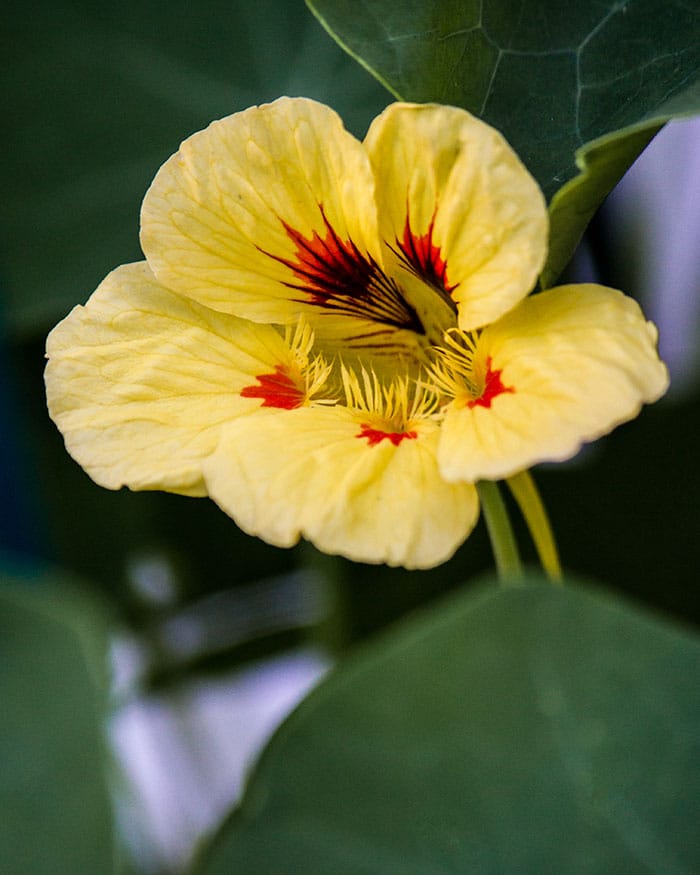
There’s not much discussion about nasturtiums (Tropaeolum major), and apparently little work done to breed new colours. It could be the genes are resistant to manipulation, or perhaps not enough gardeners grow these easy and cheerful plants to attract breeders’ attention.
Just a bit of sleuthing around reveals named cultivars (and available seeds) we don’t often see. In the familiar mix of warm primary colours (yellow, orange, red) there is a good pink, ‘Cherry Rose Jewel’, a clump-forming plant with upturned and deeply saturated cherry-rose flowers. It’s always worthwhile to grow a pot of ‘Empress of India’ for its remarkably dark blue-green foliage and intense crimson-scarlet flowers. These have been listed in catalogues going back into the 19th-century, and are complimentary to other dark foliage, like the Sidekick Black Heart sweet potato vine (Ipomoea batatas ‘Seki Blahrt’) I bought his year, described as having garnet-purple foliage, although mine is almost black.
There is also dwarf nasturtium ‘King Theodore’ (T. minus ‘King Theodore’), and I wonder which monarch that was? This is another oldie from centuries past, with dark leaves and intense crimson flowers with deep chocolate brown flushes on the petals. Even more appealing is nasturtium ‘Black Velvet’, another heritage cultivar with more black and less crimson in velvety flowers on dwarf plants—quite dramatic. My current favourite is ‘Peach Melba’, a compact plant with blue-grey foliage and sweet yellow blossoms, each marked with maroon splashes in the throat. ‘Peach Melba’ has enough style and interest to be grown on its own in a large pot.
Recently, I saw a mixed container with variegated nasturtium ‘Alaska’ used as a filler, in combination with Superbena Dark Blue verbena (‘Usbenal8’) and chartreuse Wasabi coleus (‘UF0843’), and realized the green and white nasturtium foliage is an inspired filler in any planting. In fact, the leaves are so light and interesting, you can take all the edible flowers off for salads.
Other useful nasturtiums are the trailing varieties, and this group includes the double-flowered ‘Darjeeling Gold’ and double orange ‘Hermine Grasshof’, both surprising flowers if you’ve never seen double nasturtiums. Of course, to my eye they no longer look quite like nasturtiums, but you know what a traditional gardener I am. These trailing plants will drip from containers. Planted in the ground, they generously spill forward across a stone walk. Monet cleverly used cascading nasturtiums to soften the gravel pathways at Giverny.

I remember my grandmother using these plant greens on her sandwich and it still remains a favorite of mine. I’ll plant a few in the town boxes as fillers. I am working for the municipality here in Killarney as I am a Master Gardener/Horticulturist.
These are an old favorite as the locals remember them in family gardens years ago. The new colours and variegated leaves are very pretty.
As always a great magazine and article as well.
Marlene Kutcher Legault
Hi Marlene (July 5),
Yes, nasturtium sandwiches are a summer treat, on buttered bread with sliced boiled eggs and mayonnaise. Recipe courtesy of my own granny!
— Judith
Hi Judith, I love nasturtiums. Every time I plant them they get thick with black mite-type bugs. It is like they come from within? Any suggestions on how to discourage them? Thanks,Cathy
Hi Cathy (July 5),
The tiny black bugs are a species of aphid. Nasturtiums are often used as a “trap plant” to lure the black aphids away from other flowers and vegetables. I wonder if you could avoid the black aphids by growing the nasturtiums in a different location? Beneficial insects (like lady bug beetles) may eventually prey on the aphids, but truthfully, there aren’t any guaranteed treatments. However, black aphids don’t appear every year, and you may avoid them some seasons. So far, I haven’t seen any on my plants this summer (but have had them other years).
— Judith